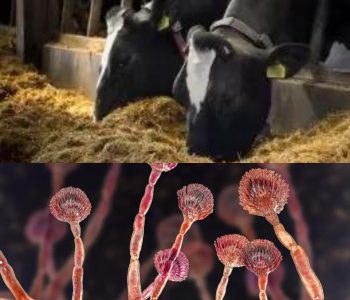Turmeric and the potential to mitigate AFB1 toxicity through its inclusion in dairy cow diets.
Aflatoxin contamination represents a food safety challenge for both animals and people. This type of contamination and its associated health hazards are referred to as Aflatoxicosis. Aflatoxins (AFs) are widespread dangerous mycotoxins synthesized by Aspergillus flavus and A. parasiticus that contaminate several foods and feed commodities [1].
Aflatoxicosis severity varies according to dose, exposure time, species, age, sexual cycle, nutritional status, etc.
Although the optimal conditions for the occurrence of this mycotoxicosis are found in tropical and subtropical regions, AFs have become a growing concern in southern EU countries during the last decades. A number of studies highlight climate change as a major factor for this. Playing a significant role in the rise of AF contamination in corn worldwide[2,3].
Aflatoxins hold a variety of toxic effects that can be elicited by the bioactivation of drug-metabolizing enzymes. This is especially true for cytochrome P450 (CYP)3A and 1A, which are responsible for the generation of both AFM1 and AFB epoxide (AFBO). The latter considered to be the most toxic. Being a reactive genotoxic hepatocarcinogen responsible which also causes cytotoxic effects and oxidative stress.
Their main toxic and carcinogenic effects include:
- Hepatotoxicity, hepatocarcinogenic
- Neurotoxicity, nephrotoxicity
- Hemotoxicity
- Enterotoxicity
- Osteotoxicity
- Inmunosuppresant
The main clinical signs that occur are:
- Anorexia
- ↓ body weight
- ↓ productivity (eggs or milk)
- Bleeding
- Embryotoxicity
- ↓ reproductive performance
- ↑ disease susceptibility
What is known about aflatoxins?
- AFB1 is considered the most important compound in terms of prevalence and toxicity for both humans and farm animals.
- AFM1 is the main toxic metabolite of AFB1, found in milk and dairy products from AF-exposed dairy cows, posing a further health risk for consumers.
Mechanisms of Aflatoxin Excretion in ruminants:
- Feces: 55-80%
- Urine: 10-20%
- Meat: <1%
- Milk: 1-3%
Carry over = Percentage of AFB1 excreted in milk as the metabolite AFM1.
This rate varies between 1-3% (min. 0.1% and max. 10%) and depends on:
- Species: dairy cattle, sheep or milk goats (dott. Battacone)
- Production level and days in milk
- Somatic cells, due to membrane permeability. Masoero et al. (2017).
These authors showed that cows with high somatic cell counts excrete more AFM1 in milk than cows with similar production levels but with lower somatic cell counts.
Finding alternatives to prevent and protect against Aflatoxicosis
- In order to protect animal and human health (EU Regulation 574/2011) establishes maximum AFM1 residue levels in feed materials, and compound feed for dairy cattle. As well as a limit of 0.05 μg AFM1/kg for dairy milk (EU Regulation 165/2010).
- The use of binders (e.g., clays, aluminosilicates, yeast cell walls and many others) which are capable of forming complexes with these toxins, are a widespread strategy to prevent their enteric absorption. However, the use of these binders brings along potentially negative side effects. As these compounds adsorb amino acids, vitamins as well as some feed additives, which hampers animal health and performance.
- Therefore, great interest has been placed on finding alternative natural compounds that help mitigate the deleterious effects of AFB1. Contributing to reduce the accumulation of its metabolites in food animal tissues as well as the contamination of milk and other dairy products with AFM1.
- Curcumin and curcuminoids (i.e., desmethoxycurcumin and bis-desmethoxycurcumin)derived from turmeric (Curcuma longa) are receiving growing attention, based on their numerous beneficial properties including anti-inflammatory, antineoplastic and antioxidant effects in humans and in various animal species [18,19]. Such properties, particularly the ability displayed by turmeric derivatives of acting as free radical scavengers.
- Previous studies have documented in vivo mitigation of AFB1 toxicity through the use of Curcumin and curcuminoidin in rats and broiler chicks.
- There are no previous studies documenting the potential ability to reduce AFM1 synthesis and/or milk excretion in dairy cows through the use of either of these compounds.
Study
Under such context, a study was carried out at the University of Bologna, Italy, to assess if the inclusion of turmeric powder and the compounds(Curcumin and curcuminoids), could contribute to reducing AFM1 and AFL milk content in lactating dairy cows exposed to dietary AFB1.
Materials and methods
A crossover design was applied to two groups of cows (n = 4 each) with a 4-day washout. Animals received a diet contaminated with low AFB1 levels (5 ± 1 µg/kg) for 10 days ± TP supplementation (20 g/head/day).
- The dairy cows which were fed a compound feed diet contaminated with AFB1 concentrations at the maximum limits established by the EU; exhibited AFM1 milk levels at EU statutory limits and above for the studied period.
- Milk characteristics and milk yield were not modified by the dietary treatment.
- Turmeric powder supplementation at a concentration considered safe by EFSA, did not reduce AFM1 milk content in a statistically significant way.
- Considering the fact that bioavailability poses certain challenges, researchers state that further studies must be carried out before making final conclusions regarding TP’s potential to mitigate AFM1 excretion in dairy. AS a more bioavailable formulation may prove to be effective for such purpose.
You may also like to read: “Mycotoxin contamination in meat and meat products”
